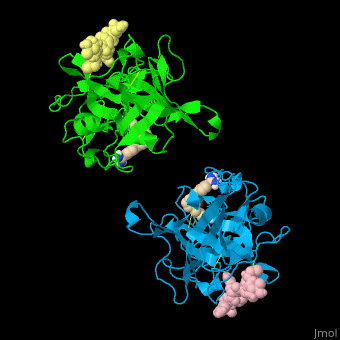Plasminogen activator
From Proteopedia
(Difference between revisions)
| Line 9: | Line 9: | ||
Treatment with tissue PLA for acute ischemic stroke is beneficial<ref>PMID:7477192</ref>. | Treatment with tissue PLA for acute ischemic stroke is beneficial<ref>PMID:7477192</ref>. | ||
== Structural highlights == | == Structural highlights == | ||
| - | + | *<scene name='47/476004/Cv/2'>Interactions between tissue plasminogen activator light chain catalytic domain and heavy chain catalytic domain fragment</scene>. Water molecules shown as red spheres. | |
| + | *<scene name='47/476004/Cv/3'>Benzamidine binding site</scene>. | ||
</StructureSection> | </StructureSection> | ||
==3D structures of plasminogen activator== | ==3D structures of plasminogen activator== | ||
Revision as of 11:49, 3 September 2017
| |||||||||||
3D structures of plasminogen activator
Updated on 03-September-2017
References
- ↑ Sodeinde OA, Sample AK, Brubaker RR, Goguen JD. Plasminogen activator/coagulase gene of Yersinia pestis is responsible for degradation of plasmid-encoded outer membrane proteins. Infect Immun. 1988 Oct;56(10):2749-52. PMID:2843471
- ↑ . Tissue plasminogen activator for acute ischemic stroke. The National Institute of Neurological Disorders and Stroke rt-PA Stroke Study Group. N Engl J Med. 1995 Dec 14;333(24):1581-7. PMID:7477192 doi:http://dx.doi.org/10.1056/NEJM199512143332401

